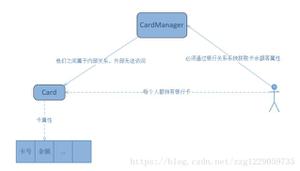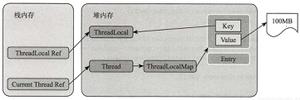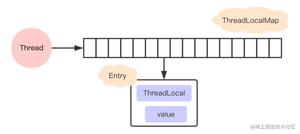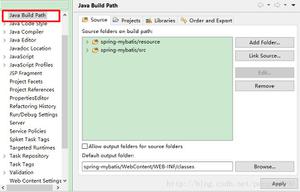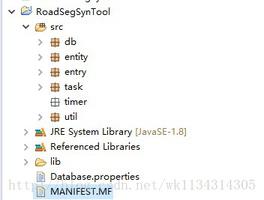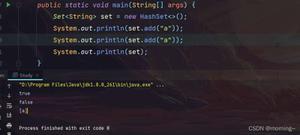快速了解Java中ThreadLocal类
最近看Android FrameWork层代码,看到了ThreadLocal这个类,有点儿陌生,就翻了各种相关博客一一拜读;自己随后又研究了一遍源码,发现自己的理解较之前阅读的博文有不同之处,所以决定自己写篇文章说说自己的理解,希望可以起到以下作用:
- 可以疏通研究结果,加深自己的理解;
- 可以起到抛砖引玉的作用,帮助感兴趣的同学疏通思路;
- 分享学习经历,同大家一起交流和学习。
一、 ThreadLocal 是什么
ThreadLocal 是Java类库的基础类,在包java.lang下面;
官方的解释是这样的:
Implements a thread-local storage, that is, a variable for which each thread has its own value. All threads share the same ThreadLocal object, but each sees a different value when accessing it, and changes made by one thread do not affect the other threads. The implementation supports null values.
大致意思是:
可以实现线程的本地存储机制,ThreadLocal变量是一个不同线程可以拥有不同值的变量。所有的线程可以共享同一个ThreadLocal对象,但是不同线程访问的时候可以取得不同的值,而且任意一个线程对它的改变不会影响其他线程。类实现是支持null值的(可以在set和get方法传递和访问null值)。
概括来讲有三个特性:
- 不同线程访问时取得不同的值
- 任意线程对它的改变不影响其他线程
- 支持null
下面分别对这些特性进行实例验证,首先定义一个Test类,在此类中我们鉴证上边所提到的三个特性。类定义如下:
Test.java
public class Test{
//定义ThreadLocal
private static ThreadLocal name;
public static void main(String[] args) throws Exception{
name = new ThreadLocal();
//Define Thread A
Thread a = new Thread(){
public void run(){
System.out.println("Before invoke set,value is:"+name.get());
name.set(“Thread A”);
System.out.println("After invoke set, value is:"+name.get());
}
}
;
//Define Thread B
Thread b = new Thread(){
public void run(){
System.out.println("Before invoke set,value is :"+name.get());
name.set(“Thread B”);
System.out.println("After invoke set,value is :"+name.get());
}
}
;
// Not invoke set, print the value is null
System.out.println(name.get());
// Invoke set to fill a value
name.set(“Thread Main”);
// Start thread A
a.start();
a.join();
// Print the value after changed the value by thread A
System.out.println(name.get());
// Start thread B
b.start();
b.join();
// Print the value after changed the value by thread B
System.out.println(name.get())
}
}
代码分析:
从定义中我们可以看到只声明了一个ThreadLocal对象,其他三个线程(主线程、Thread A和Thread B)共享同一个对象;然后,在不同的线程中修改对象的值和在不同的线程中访问对象的值,并在控制台输出查看结果。
看结果:
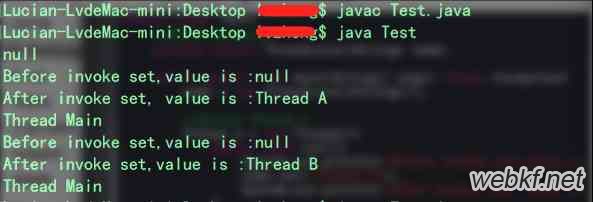
从控制台输出结果可以看到里边有三个null的输出,这个是因为在输出前没有对对象进行赋值,验证了支持null的特点;再者,还可以发现在每个线程我都对对象的值做了修改,但是在其他线程访问对象时并不是修改后的值,而是访问线程本地的值;这样也验证了其他两个特点。
二、 ThreadLocal的作用
大家都知道它的使用场景大都是多线程编程,至于具体的作用,这个怎么说那?我觉得这个只能用一个泛的说法来定义,因为一个东西的功能属性定义了以后会限制大家的思路,就好比说菜刀是用来切菜的,好多人就不会用它切西瓜了。
这里,说下我对它的作用的认识,仅供参考,希望能有所帮助。这样来描述吧,当一个多线程的程序需要对多数线程的部分任务(就是run方法里的部分代码)进行封装时,在封装体里就可以用ThreadLocal来包装与线程相关的成员变量,从而保证线程访问的独占性,而且所有线程可以共享一个封装体对象;可以参考下Android里的Looper。不会用代码描述问题的程序员不是好程序员;
看代码:统计线程某段代码耗时的工具(为说明问题自造)
StatisticCostTime.java
// Class that statistic the cost time
public class StatisticCostTime{
// record the startTime
// private ThreadLocal startTime = new ThreadLocal();
private long startTime;
// private ThreadLocal costTime = new ThreadLocal();
private long costTime;
private StatisticCostTime(){
}
//Singleton
public static final StatisticCostTime shareInstance(){
return InstanceFactory.instance;
}
private static class InstanceFactory{
private static final StatisticCostTime instance = new StatisticCostTime();
}
// start
public void start(){
// startTime.set(System. nanoTime ());
startTime = System.nanoTime();
}
// end
public void end(){
// costTime.set(System. nanoTime () - startTime.get());
costTime = System.nanoTime() - startTime;
}
public long getStartTime(){
return startTime;
// return startTime.get();
}
public long getCostTime(){
// return costTime.get();
return costTime;
}
好了,工具设计完工了,现在我们用它来统计一下线程耗时试试呗:
Main.java
public class Main{
public static void main(String[] args) throws Exception{
// Define the thread a
Thread a = new Thread(){
public void run(){
try{
// start record time
StatisticCostTime.shareInstance().start();
sleep(200);
// print the start time of A
System.out.println("A-startTime:"+StatisticCostTime.shareInstance().getStartTime());
// end the record
StatisticCostTime.shareInstance().end();
// print the costTime of A
System.out.println("A:"+StatisticCostTime.shareInstance().getCostTime());
}
catch(Exception e){
}
}
}
;
// start a
a.start();
// Define thread b
Thread b = new Thread(){
public void run(){
try{
// record the start time of B1
StatisticCostTime.shareInstance().start();
sleep(100);
// print the start time to console
System.out.println("B1-startTime:"+StatisticCostTime.shareInstance().getStartTime());
// end record start time of B1
StatisticCostTime.shareInstance().end();
// print the cost time of B1
System.out.println("B1:"+StatisticCostTime.shareInstance().getCostTime());
// start record time of B2
StatisticCostTime.shareInstance().start();
sleep(100);
// print start time of B2
System.out.println("B2-startTime:"+StatisticCostTime.shareInstance().getStartTime());
// end record time of B2
StatisticCostTime.shareInstance().end();
// print cost time of B2
System.out.println("B2:"+StatisticCostTime.shareInstance().getCostTime());
}
catch(Exception e){
}
}
}
;
b.start();
}
}
运行代码后输出结果是这样的
注意:输出结果精确度为纳秒级

看结果是不是和我们预想的不一样,发现A的结果应该约等于B1+B2才对呀,怎么变成和B2一样了那?答案就是我们在定义startTime和costTime变量时,本意是不应共享的,应是线程独占的才对。而这里变量随单例共享了,所以当计算A的值时,其实startTime已经被B2修改了,所以就输出了和B2一样的结果。
现在我们把StatisticCostTime中注释掉的部分打开,换成ThreadLocal的声明方式试下。
看结果:

呀!这下达到预期效果了,这时候有同学会说这不是可以线程并发访问了吗,是不是只要我用了ThreadLocal就可以保证线程安全了?答案是no!首先先弄明白为什么会有线程安全问题,无非两种情况:
1、不该共享的资源,你在线程间共享了;
2、线程间共享的资源,你没有保证有序访问;
前者可以用“空间换时间”的方式解决,用ThreadLocal(也可以直接声明线程局部变量),后者用“时间换空间”的方式解决,显然这个就不是ThreadLocal力所能及的了。
三、 ThreadLocal 原理
实现原理其实很简单,每次对ThreadLocal 对象的读写操作其实是对线程的Values对象的读写操作;这里澄清一下,没有什么变量副本的创建,因为就没有用变量分配的内存空间来存T对象的,而是用它所在线程的Values来存T对象的;我们在线程中每次调用ThreadLocal的set方法时,实际上是将object写入线程对应Values对象的过程;调用ThreadLocal的get方法时,实际上是从线程对应Values对象取object的过程。
看源码:
ThreadLocal 的成员变量set
/**
* Sets the value of this variable for the current thread. If set to
* {@code null}, the value will be set to null and the underlying entry will
* still be present.
*
* @param value the new value of the variable for the caller thread.
*/
public void set(T value) {
Thread currentThread = Thread.currentThread();
Values values = values(currentThread);
if (values == null) {
values = initializeValues(currentThread);
}
values.put(this, value);
}
TreadLocal 的成员方法get
/**
* Returns the value of this variable for the current thread. If an entry
* doesn't yet exist for this variable on this thread, this method will
* create an entry, populating the value with the result of
* {@link #initialValue()}.
*
* @return the current value of the variable for the calling thread.
*/
@SuppressWarnings("unchecked")
public T get() {
// Optimized for the fast path.
Thread currentThread = Thread.currentThread();
Values values = values(currentThread);
if (values != null) {
Object[] table = values.table;
int index = hash & values.mask;
if (this.reference == table[index]) {
return (T) table[index + 1];
}
} else {
values = initializeValues(currentThread);
}
return (T) values.getAfterMiss(this);
}
ThreadLocal的成员方法initializeValues
/**
* Creates Values instance for this thread and variable type.
*/
Values initializeValues(Thread current) {
return current.localValues = new Values();
}
ThreadLocal 的成员方法values
/**
* Gets Values instance for this thread and variable type.
*/
Values values(Thread current) {
return current.localValues;
}
那这个Values又是怎样读写Object那?
Values是作为ThreadLocal的内部类存在的;这个Values里包括了一个重要数组Object[],这个数据就是解答问题的关键部分,它是用来存储线程本地各种类型TreadLocal变量用的;那么问题来了,具体取某个类型的变量时是怎么保证不取到其他类型的值那?按一般的做法会用一个Map根据key-value映射一下的;对的,思路就是这个思路,但是这里并没有用Map来实现,是用一个Object[]实现的Map机制;但是,若要用Map理解的话,也是不可以的,因为机制是相同的;key其实上对应ThreadLocal的弱引用,value就对应我们传进去的Object。
解释下是怎么用Object[]实现Map机制的(参考图1);它是用数组下标的奇偶来区分key和value的,就是下表是偶数的位置存储key,奇数存储value,就是这样搞得;感兴趣的同学如果想知道算法实现的话,可以深入研究一下,这里我不在详述了。

结合前面第一个实例分析下存储情况:
当程序执行时存在A,B和main三个线程,分别在线程中调用name.set()时同时针对三个线程实例在堆区分配了三块相同的内存空间来存储Values对象,以name引用作为key,具体的object作为值存进三个不同的Object[](参看下图):
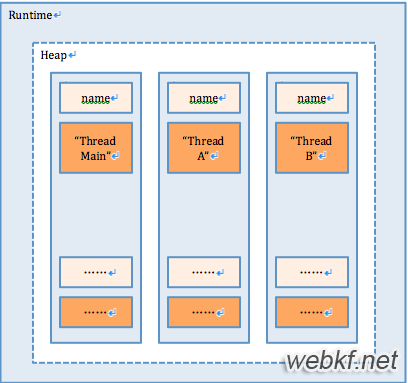
四、 总结
ThreadLocal 不能完全解决多线程编程时的并发问题,这种问题还要根据不同的情况选择不同的解决方案,“空间换时间”还是“时间换空间”。
ThreadLocal最大的作用就是把线程共享变量转换成线程本地变量,实现线程之间的隔离。
以上就是本文关于快速了解Java中ThreadLocal的全部内容,希望对大家有所帮助。如有不足之处,欢迎留言指出。感谢朋友们对本站的支持。
以上是 快速了解Java中ThreadLocal类 的全部内容, 来源链接: utcz.com/p/214854.html

